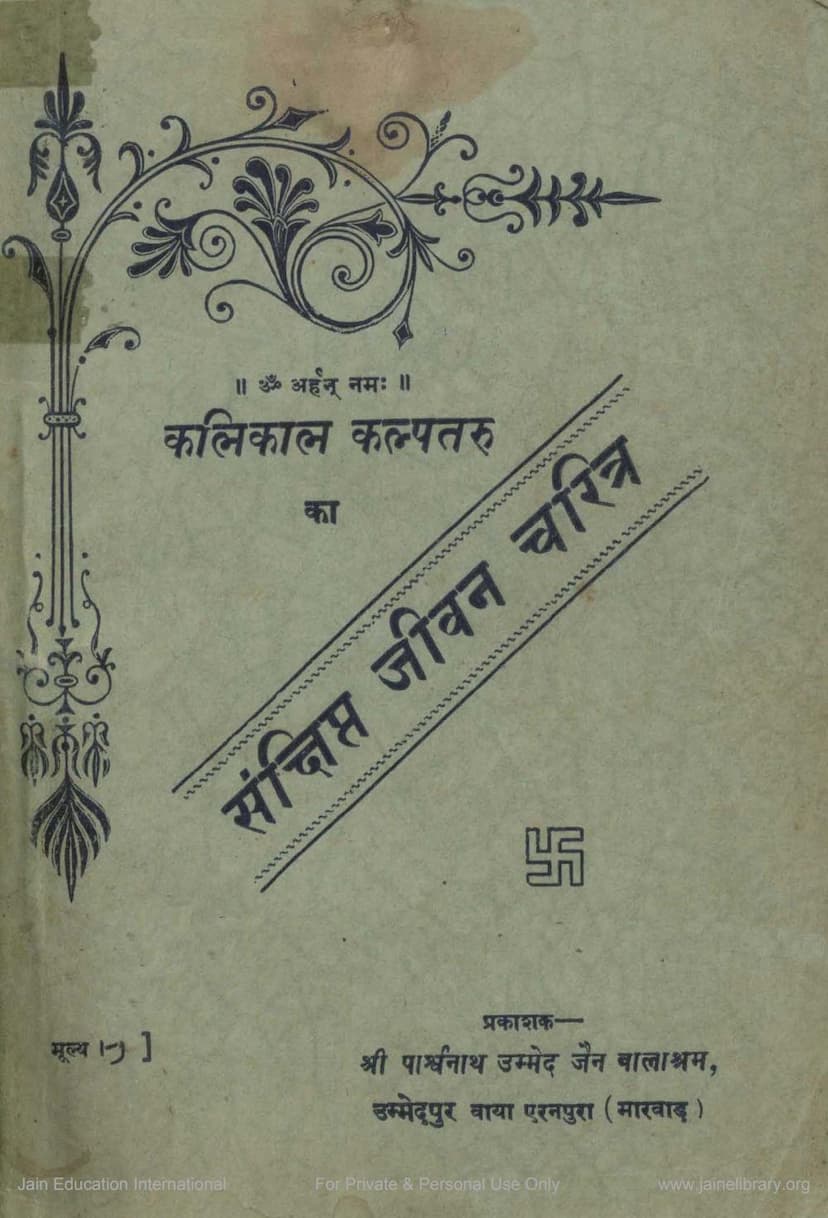Kalikal Kalpataru Vijay Vallabhsuriji Ka Sankshipta Jivan Charitra
Added to library: September 2, 2025

Summary
This document is a biographical account of Acharya Shri Vijayavallabh Surishwarji Maharaj, titled "Kalikal Kalpataru Vijay Vallabhsuriji ka Sankshipta Jivan Charitra" (A Concise Biography of Acharya Shri Vijayavallabh Surishwarji, the Wish-Fulfilling Tree of the Kali Age). Published by Shri Parshwanath Umed Jain Balashram, Umedpur, in 1938 (Samvat 1995), it details the life and significant contributions of this revered Jain acharya.
The book begins with a devotional invocation and introduces Acharya Vijayavallabh Surishwarji Maharaj as the successor of Acharya Shri Vijayanand Surishwarji Maharaj (also known as Shri Atmaramji Maharaj), hailing him as a beacon of knowledge in the era of ignorance.
The biography then delves into his early life, describing his birth as Chhaganlal in Baroda (Vadodara) to pious parents. It highlights his naturally calm and obedient disposition from childhood. The narrative traces his early education, his growing disinterest in worldly studies, and his increasing inclination towards spirituality and the company of saints. It recounts the challenges he faced from his elder brother who wanted him to focus on business, and his own internal struggle for true happiness and liberation from worldly suffering.
A significant turning point in his life was attending the sermons of Acharya Shri Atmaramji Maharaj, which solidified his desire for renunciation. Despite initial familial resistance, he eventually received initiation at the age of 17 in Radhanpur in Samvat 1944 (1887 CE), becoming Muni Shri Vallabhvijayji. The text emphasizes the auspicious astrological signs at his initiation, predicting his future greatness.
The biography then chronicles his extensive travels and his profound impact on the Jain community, particularly in Punjab. It highlights his role in:
- Religious Propagation and Defense: Engaging in numerous scholarly debates (shastrarths) with other religious sects, effectively defending Jain tenets and protecting the Jain community from criticism and opposition. His intellectual prowess and powerful oratory are consistently emphasized.
- Educational Reforms and Institutions: Establishing and promoting educational institutions like the Shri Atmanand Jain Pathshalas, Shri Atmanand Jain Gurukul, and Shri Atmanand Jain College in Ambala. He strongly advocated for education as a means of societal upliftment and modernization for the Jain community.
- Social Harmony and Reform: Working to resolve internal conflicts and foster unity within the Jain community, bridging differences between various sects and individuals.
- Inspirational Leadership: Leading by example through his asceticism, devotion, and unwavering commitment to the Jain way of life. He inspired thousands, including non-Jains, to embrace spiritual paths and contribute to social welfare.
- Writings and Publications: Collaborating with his guru in writing significant Jain texts like 'Tatvanirnayaprasad' and 'Chikago Prashnottar'.
- Spiritual Guidance: Guiding his disciples, including Muni Shri Lalitvijayji and Muni Shri Sohanvijayji, whom he nurtured to become significant figures in the Jain tradition.
The text details numerous instances of his impactful sermons, his interactions with royalty and influential figures, and the widespread reverence he commanded. It also recounts personal hardships and challenges, such as a robbery incident during his travels, which he faced with equanimity and faith.
A significant portion of the biography is dedicated to his efforts in Punjab, where he is credited with revitalizing Jainism, establishing educational institutions, and fostering a sense of unity and purpose. His return to Punjab after many years was met with immense enthusiasm and celebration, marking a significant revival of religious fervor.
The book further describes his later years, including his assumption of the prestigious 'Acharya' title in Lahore in Samvat 1981 (1924 CE), a significant event for the Jain community in Punjab. It highlights his continued dedication to teaching, writing, and spiritual guidance, as well as his efforts in establishing numerous educational and religious centers across various regions of India.
The biography concludes by reiterating his deep guru-bhakti and his relentless pursuit of Jainism's upliftment, emphasizing his unique qualities of renunciation, wisdom, and profound spiritual influence that touched the lives of countless individuals. The narrative is rich with anecdotes and examples illustrating his character and the impact of his life's work.